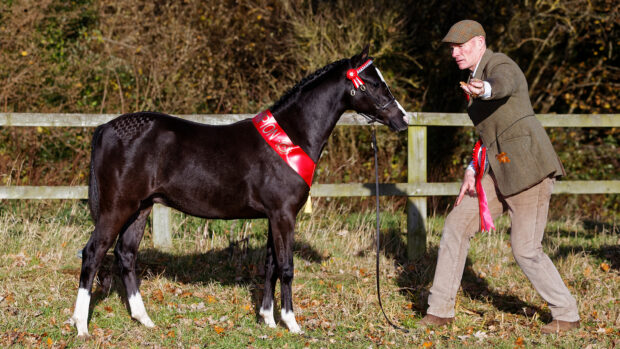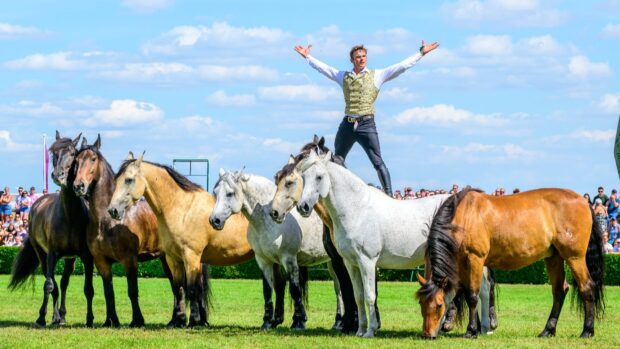The originators of natural horsemanship are widely considered to be Tom and Bill Dorrance, raised in the early 1900s on an Oregon cattle ranch. They promoted a kinder, less violent form of horse training than was typical at the time, and influenced later trainers including Monty Roberts.
Many natural horsemanship trainers focus on groundwork to establish a connection with their horse and teaching them to respect space. They tend to challenge the “this is how we’ve always done it” way of thinking.
What is ‘natural horsemanship’?
Tricky to define and deemed a controversial subject by some – particularly when it comes to Parelli – we asked well-known names in the world of ‘natural horsemanship’, as well as riders competing in mainstream disciplines, what the term means to them.
Monty Roberts, an American whose methods were first put before a UK audience by The Queen more than 30 years ago, is perhaps the first name that springs to mind with natural horsemanship. Monty himself, however, dismisses the term.
“There is nothing on this earth that could be considered ‘natural horsemanship’. It’s fine that it becomes a brand name for an individual, however it’s impossible to consider anything that we do with horses as natural, when they are designed to be grazing large tracks of land, able to see for significant distances in all directions.
“I love the fact horses will allow us to be unnatural enough to become willing partners with us. We owe them good horsemanship; that has been my aim.”
Your Horsemanship’s Jason Webb agrees, saying he doesn’t describe himself as a ‘natural horseman’, as he feels the term has moved away from the common sense, practical-based training he uses and promotes.
“I grew up in Australia learning and developing methods handed down through generations that use the horse’s natural instincts to train the horse,” he says.
The idea that many aspects of natural horsemanship are integral to conventional training is something trainer and former eventer Kath Pinington and dressage rider Laura Milner agree on.
“To me, a lot of the techniques are just good, common sense horsemanship. What the most successful natural horsemanship trainers have done is to put those techniques into an orderly fashion so that people can learn them,” says Kath.
Laura Milner has used natural horsemanship trainer Guy Robertson for some of her more challenging youngsters, and says she is comfortable with using aspects of natural horsemanship within her own dressage work.
“Watching Guy work, it has been very much based on teaching the horse about respecting space, starting with groundwork and going from there,” says Laura.
Kelly Marks, founder of Intelligent Horsemanship, says for her it’s about thinking from the horses’ point of view and developing feel and timing, rather than relying on brute force and fear.
“We take the best non-violent aspects of traditional horsemanship and combine that with the latest science available. Our aim is always to do the very best for horses as well as helping the horse/human relationship, which is vital,” she says.
Gary Witheford, whose website describes his system as “sound horsemanship” agrees the people part of the relationship is fundamental.
“Getting people to change their ways, to stop saying ‘this is how we’ve always done it’ is key. Once they understand the use of pressure/release, for example, to reward horses for coming forward, everything becomes easier,” he says.
For former international eventer turned trainer Tracey Dillon, natural horsemanship is just the new name for aspects of basic good horsemanship.
“It brings together different aspects under one banner, but is limited by the concepts involved, as a specific type of natural horsemanship only includes what suits that person’s philosophies. If you only stick to [a certain type of] natural horsemanship the benefits of combining other systems to tailor interactions and therefore communication with each horse individually, are lost,” she warns.
While the term natural horsemanship might bring to mind connotations of horse whisperers in Stetson hats, there’s no doubt the non-violent training philosophy that sits at its heart should be considered a step forward.
“Remember, we broke horses using abject violence for almost 6,000 years. It’s time to take pride in the changes that are being made,” says Monty Roberts.
Natural horsemanship training for beginners
There are a lot of trainers who offer natural horsemanship clinics, but with it being such a wide-reaching term there will be a lot of variation. If you’re interested in natural horsemanship and would like to learn more, it would be worth researching a range of trainers and considering whose methods you find most suited to you. Many horse owners like to ‘pick and mix’ methods and techniques used by different trainers. Read about their courses, watch their videos and read the reviews.
As it’s not a sport, there is no overall regulatory body and so no way of choosing an approved trainer. You can, however, find trainers that are approved by a particular training group, such as Intelligent Horsemanship. These trainers will have completed a number of training courses.
Natural horsemanship equipment
Followers of the training method tend to use similar kit and training tools to communicate with their horse.
Rope halter
A rope halter is made to put pressure on a smaller area so that you can give subtle aids more directly and precisely than you could with a headcollar. Check out this selection of the best rope halters.
Communication rope
Long ropes allow you to give aids to your horse when he’s close to you as well as further away. Ropes used in natural horsemanship tend to be a bit heavier than a normal lunge line, which allows you to give more precise aids.
Contact stick
A contact stick is used as an extension of your arm to give aids further away from you. They’re not flexible – like a whip would be – which means you can apply pressure or stroke very precisely.
Bitless bridle
Some natural horsemanship trainers prefer to use bitless bridles – we’ve rounded up the best bitless bridles for beginners.
Bareback pad
Riding bareback isn’t always comfortable, but a bareback pad, which is a thick pad with a soft bottom and a stiffer top, can help with this. You can attach a normal short girth to it.

AMKA Contact Stick at amazon.co.uk
This 1m contact stick with rope and rubber handle is ideal for practising ground work.

QHP Ceto bitless bridle at equus.co.uk
This multifunctional horse bridle is ideal for those new to bitless as it can be used as a side-pull, chin-cross or jaw-cross bridle.
Additional reporting by Georgia Guerin
You might also like:

Parelli Natural Horsemanship: what’s the verdict?
This month marks the 35th anniversary of Pat Parelli’s first seminar. H&H talks to the trainer himself and finds out

Monty Roberts: ‘There’s no such thing as natural horsemanship’

7 rope halters that give more precise aids for training

Subscribe to Horse & Hound magazine today – and enjoy unlimited website access all year round
Horse & Hound magazine, out every Thursday, is packed with all the latest news and reports, as well as interviews, specials, nostalgia, vet and training advice. Find how you can enjoy the magazine delivered to your door every week, plus options to upgrade your subscription to access our online service that brings you breaking news and reports as well as other benefits.







